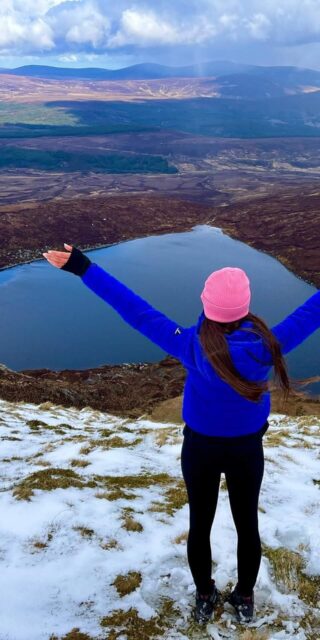Wicklow Way Stage 4
Distance: 26km (approx.)
The toughest day! Two big climbs lie ahead, an early start is advised. As we leave the valley floor our first climb starts. Progressing higher through the conifer forest we reach one of the highest points on the Wicklow Way; the Mullacor Saddle. Our views to the south now open out ahead of us and Wicklow’s highest mountain, Lugnaquilla with its broad summit plateau comes into view.
Don’t miss the Mullacor Hut which is tucked into the forest to our left as we descend into the valley, it’s easily missed. Glenmalure provides a welcome respite before the next climb. The route follows mainly forest tracks passing the second hut of the day at Mucklagh. Our final descent brings us to Iron Bridge and the end of a long day.
DOWNLOAD YOUR MAP HERE (TBC)
As you descend into Glenmalure, spare a thought for whose footsteps you follow. 16th Century potential High King, Red Hugh O’Donnell, who together with the O’Neill brothers escaped from Dublin Castle to Glenmalure, aided and abetted by the infamous O’Byrne Clan. Two centuries later, The United Irishmen ensured the stronghold of Glenmalure remained a thorn in the oppressor’s side. Fleeing rebels being the reason for the military roads which pass over Wicklow’s mountains and allows us easy access to the hills today.
Drumgoff Crossroads, in the heart of the Glenmalure Valley provides a welcome sanctuary to walkers. The Glenmalure Lodge, a proper Irish pub, with its’ welcome fire and hearty meals proves the downfall of many walkers who had planned to continue further on this walking day.
Accommodation in the valley is sought after all year round, so advance booking is advised.
Additional services including public transport options are located in Rathdrum, approximately 10km away.
Distance walked on this stage so far:
Stage 4: N – S: Distance walked from Glendalough: 13.5km (approx.)
Stage 4: S – N: Distance walked from Aughavanna (Ironbridge): 12.5km (approx.)
Things to do & see near here:
Check out where Bosca Beatha’s mobile sauna is during your visit, it often comes to Glenmalure and really, do you need encouragement after a few days of walking? View local creativity at its’ best at Crannmor Pottery or Shekina Sculpture Garden just down the road (please phone ahead). Play a round of golf at the Glenmalure Golf Club. Visit Avondale House & Forest Park, homeplace of Charles Stewart Parnell in nearby Rathdrum. Spend a relaxing afternoon at Greenan Maze, farm and tea rooms or Kilmacurragh Botanic Gardens and café. Go kayaking or play a game of Laser Tag with Wicklow Adventures at Hidden Valley Holiday Park.
Aughavannagh (Ironbridge) & Aughrim:
You have reached the end of this stage when, after popping out of the forestry once again onto another country road, you see a large parking area and the narrow iron bridge over the Ow River.
Ironbridge is a well-known pick up location amongst Wicklow Way accommodation providers and the Wicklow Way Bus can also pick you up here, provided you book ahead.
Aughavannagh itself is a typical rural townland, where homes cluster together to form a village of sorts. However, accommodation is extremely limited here, with both former hostels no longer operating. Many walkers choose to continue along The Wicklow Way for another 1.5km or so, until they, quite literally, walk into the grounds of Ballyteige Lodge, keep an eye out for the sign.
Others opt to stay in the nearby picturesque village of Aughrim, or ‘The Granite City’, as it is known locally. Surrounded by woodlands, hills and at the confluence of the Ow and Derry Rivers, staying in this multi award winning village is also an ideal opportunity to top up on supplies before continuing your journey along The Wicklow Way.
Services here are by and large based in Aughrim, approximately 9km from Ironbridge.
Things to do & see near here:
Go trout fishing at the award winning, wheelchair accessible NDAF Angling Park, visit Christien’s Pottery and Wood Turning Studio, play a round of golf at Macreddin Golf Club, pamper yourself with a hair, beauty or spa treatment, spend a Saturday morning picking up fresh produce and crafts at Aughrim Town & Country Market, wander along the Seán Linehan walk, watch a hurling or Gaelic football match at the O’Byrne Park, Wicklow’s county GAA grounds.
POINTS OF INTEREST
Balinafunshoge Mines
Wicklow has a long history of mining albeit on a small scale. The southern part of the county has rich seems of gold with the Glendalough and Glenmalure valleys boasting long seams of lead, zinc and silver. There is evidence of ancient mining in the valleys but the modern works dates from the 18th century and continued up until the mid-20th century. Over 2000 people were employed in mining in the area in its heyday. At Balinafunshoge there is the option to take an old mining track down to explore the old mining works. This was an extensive mine with a depth over 150m and a labyrinth of tunnels. Spoil heaps and old buildings are still easily found. Across the road on the valley floor can be found the remains of a water wheel house which was probably used to crush the ore.
Drumgoff Barracks The Irish Rebellion of 1798 was an uprising against British rule in Ireland. Many of the rebels hid out in the Wicklow Mountains, which, at the time was very inaccessible. To access the area the British build the Military Road which dissects the mountain range on a roughly north south axis. The road was to link their four barracks at Glencree, Laragh, Drumgoff and Aughavannagh. The barracks now stands in ruins having only seen limited use by the British military as a truce was signed not long after its construction.
Google Maps: 53. 956370, -6.356676
Geology: Glendalough Valley
As you stand on the beach at the Upper Lake in Glendalough look up into the valley and you’ll see a classic example of a hanging valley. It was only 12,000 years ago when the valley was covered in a thick layer of ice. This ice sheet created what we see today, the jagged cliffs, lakes and hanging valley.
Fauna: Wild Goats
The valleys in the Glendalough area are home to several small herd of wild goats. If you are down wind of the goats, you’ll smell them before you see them! Their musky, stale odour travels far and is very distinct. It’s not known if they are descendants of herds brought to the valley during the times of mining or date back further to the time of St Kevin.


